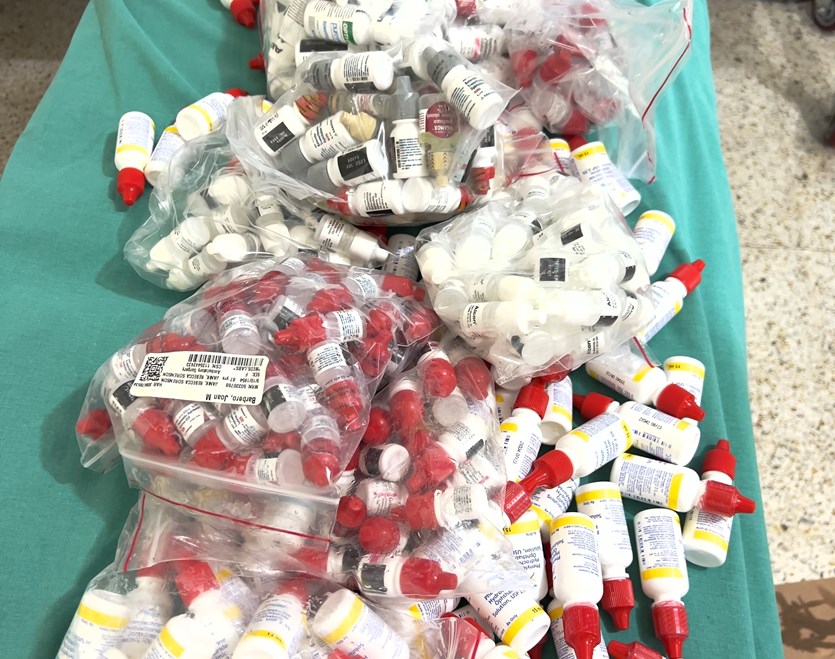

Drug Waste
Drug waste significantly increases the cost and carbon footprint of ophthalmic surgery. Find resources and solutions for drug waste reduction.
What's Important - Drug Waste

Reducing Topical Drug Waste in Ophthalmic Surgery
Surgical drug waste has a significant financial and environmental impact and may lead to drug shortages. In 2022, the OICS task force, with representatives from ASCRS, AAO, OOSS, and AGS, released a multi-society position paper endorsing several recommendations: directed at reducing unnecessary waste of topical medications. The paper was published in JCRS in 2022. Subsequently, all 50 state societies in the United States also endorsed this position paper.
Surgical facilities should be permitted to use topical drugs in multi-dose containers on multiple patients until the labeled date of expiration following proper infection control and storage guidelines. Surgical patients receiving dedicated topically applied medications should be allowed to bring their partially used medication home with them if needed for continued postoperative care.
Overview of Surgical Drug Waste
Drug Waste and Policy
Single-Use vs. Multi-Use Drugs: Risk and Cost Analyses
Is Multi-Use of Ophthalmic Medications Associated with Infection Risk?

Inappropriate Disposal of Multi-use Ophthalmic Solutions Can Lead to Drug Shortages
Visit the American Society of Health-System Pharmacists website for up-to-date information about ophthalmic drug shortages.
Policy Considerations to Prevent Drug Shortages and Mitigate Supply Chain Vulnerabilities in the United States
This White Paper report, issued by the United States Department of Health and Human Services (HHS), addresses the topic of drug shortages in the US by reviewing underlying causes and proposing policies to combat future shortages. The authors summarize the longstanding issue, identifying critical driving forces including “lack of transparency, concentration among middlemen, and prices for generic drugs that are driven [too low to create] incentives for… manufacturing, distribution, and purchasing.” The authors introduce the concepts of “supply chain resilience” and “diversification of supply” to prevent disruptions which lead to drug shortages. HHS proposes two potential long-term policies, 1) a Manufacturer Resiliency Assessment Program (MRAP), and 2) a Hospital Resilient Supply Program (HRSP) as mechanisms to meaningfully impact both the supply and demand sides of the drug market in the US.
Topical Drug Waste Legislation Passes in Colorado, Introduced in Michigan
This article discusses the passing of legislation in Colorado that allows patients to take home topical medications that were used in the OR, addressing concerns regarding both financial costs and environmental impact associated with the disposal of unused OR medications. A similar bill was introduced by Michigan in March 2024, which hopes to join a handful of states that have already begun enacting these practices. By passing this legislation, Colorado and Michigan seek to mitigate the unnecessary waste of topical drugs while ensuring patients receive appropriate treatment.
Ophthalmology Sustainability Practices and Future Directions at Northwestern Medicine
In a podcast out of Northwestern Medicine, Dr. David Palmer and Chief Sustainability Officer Jeff Good discuss the organization’s latest sustainability initiatives and specific efforts being made within ophthalmology department. At the systems level, Northwestern Medicine is working with a consultant to understand baseline greenhouse gas emissions and set targets to improve their institutional carbon footprint. Ongoing changes include being first in the nation to partner with Baxter to recycle IV bags and continuing Green Team efforts to recycle inpatient booties. Within ophthalmology, Dr. Palmer reports labeling operating room eye drop medications that patients can take home according to the Pharmacy Practice Act. In the clinic, sustainability efforts have included reducing computer power at night, using alcohol-based scrubs instead of soap and water, and installing lighting with motion detectors. The discussion emphasizes the importance of engaging individuals in both clinical and operational roles in making a meaningful difference in sustainability.
Focus on reuse: Reducing Waste Associated with Topical Pre-operative Antiseptics
Single-use topical antiseptic (5% providone-iodine (PVI) solution) generated 10.523 kg of waste over a 3-week study period in the ophthalmic operating rooms in Flinders Medical Centre, Australia. On an annual bases, this accounted for $21857.60, and 21.9% of this was was preventable. The unused topical antiseptic was successfully redirected to a local non-profit wildlife rescue organization. Further study of the risk of extrinsic contamination of multi-use PVI bottles could help mitigate financial, pharmaceutical, and environmental waste.
Drug Shortages Prior to and During the COVID-19 Pandemic
Drug shortages have surged, linked to missed dosages, errors, increased spending, and fatalities, often due to under reimbursement and quality concerns. Since 2012, companies report supply chain issues to the FDA and ASHP, including quality concerns and pandemic-related disruptions. The study aimed to quantify the association between supply chain issues and shortages from 2017 to 2021, guiding policies to safeguard medication access. Using a conceptual model, it quantifies shortages based on a 33% decrease in purchased units within six months of a reported issue, aiming to inform policies to safeguard medication access. Out of 571 drugs with 731 supply chain issues, 13.7% led to shortages, compared to 4.1% in 7296 drugs without issues, showing a significant difference. Shortages peaked from February to April 2020, declining thereafter. Differentiation was observed based on formulation, essential medicine status, and brand-name versus generic status.